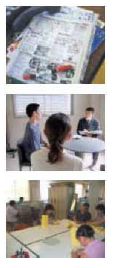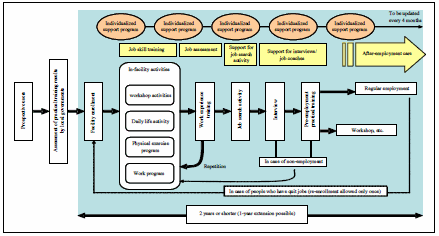Annual Report on Government Measures for Persons with Disabilities (Summary) 2006
Cabinet Office Japan
About this Report
The report on government measures for persons with disabilities is submitted to the Diet every year based on Article 11 of the Basic Law for Persons with Disabilities (Act No. 84, put into effect on May 21, 1970).
The current report, the 13th of its kind, lists measures that were taken by the government, mainly in fiscal 2005, in line with the basic directions of sector-by-sector measures called for in the Basic Program for Persons with Disabilities. The implemented measures are classified according to their purpose into four categories--“promoting mutual understanding and exchange,” “building the foundations for independence and participation in society,” “building the foundations for daily life” and “building the foundations for comfortable living environments.”
Table of Contents
Measures Taken for Persons with Disabilities (mainly in Fiscal 2005)
- Comprehensive Approach to Measures for Persons with Disabilities
- Promoting Mutual Understanding and Exchange
- Building the Foundations for Independence and Participation in Society
- Building the Foundations for Daily Life
- Building the Foundations for a Comfortable Living Environment
Special Feature
On Employment and Work Support for Persons with Disabilities
-Toward Society that Supports Pursuit of Potential-
Reference Data
- Status of children and persons with disabilities
- Current status of persons and children with disabilities
- Numbers of students at special schools for disabled people and students in special classes and "Tsukyu" classes (resource rooms)
- Status of Employment of Persons with Disabilities
Measures Taken for Persons with Disabilities (mainly in FY2005)
Explained below are measures taken by the government, mainly in fiscal 2005. These are classified by purpose into four categories--“promoting mutual understanding and exchange,” “building the foundations for independence and participation in society,” “building the foundations for daily life” and “building the foundations for comfortable living environments.”
(The principal measures cited below are, for the most part, new projects implemented in fiscal 2005 for the first time.)
1. Comprehensive Approach to Measures for Persons with Disabilities
- In fiscal 2005, progress was made strengthening the institutional framework for promoting the independence of persons with disabilities and their participation in society as the Law for Supporting Persons with Developmental Disabilities came into effect in April and the Amendment of Law for Employment Promotion, etc. of Persons with Disabilities" was enacted in June. Also, the Law for Supporting Independence of Persons with Disabilities was established in October.
- Measures for persons with disabilities were carried out in a comprehensive, carefully planned manner, across a range of areas such as employment, welfare, living conditions and education. For instance, the Law for Facilitating Mobility of Elderly Persons and Persons with Disabilities and the Bill for partial amendment of the School Education Law were submitted to the 164th session of the Diet.
[Principal Measures]
- The Law for Supporting Persons with Developmental Disabilities came into effect in April 2005, with a view to providing people afflicted by development disabilities with integrated assistance based on the collaboration of organizations engaged in a range of areas such as health and medical care, welfare, education and employment. Under the conventional approach to assistance based on the classification of disabled people into three major categories--physical and intellectual disabilities and mental disorders, it was difficult to provide appropriate assistance to people with development disabilities.
- The Law for Employment Promotion etc. of Persons with Disabilities was amended in June 2005, and the revised law was fully put into effect April 2006. The amendment aims to promote the participation in society of people with disabilities, for example by strengthening measures to help people with mental disorders obtain employment.
- The Law for Supporting Independence of Persons with Disabilities was enacted in October 2005 and fully put into effect in April 2006, with a view to establishing a system that enables municipal governments to provide welfare services in a universal manner, irrespective of the type of the recipientfs disability, whether he or she suffers from physical or intellectual disability, or a mental disorder.
Diagram 1
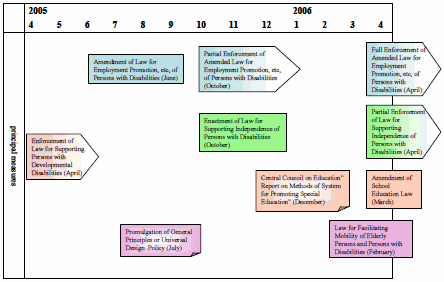
Source: Cabinet Office
- The Law for Facilitating Movements of Elderly Persons and Persons with Disabilities and the Bill for partial amendment of the School Education Law were submitted to the 164th session of the Diet.
- ”Task-Specific Promotion Teams,” which address issues that require a comprehensive and effective approach, were set up under the “Council of Directors for the Promotion of Measures for Persons with Disabilities,” which is overseen by the Headquarters for Promoting Measures for Persons with Disabilities. In November 2005, the teams identified issues concerning national qualification examinations that need to be tackled uniformly across examination subjects and conveyed the findings to government ministries and agencies.
- In accordance with the amendment of the Basic Law for Persons with Disabilities in June 2004, the “Central Consultative Council for Promotion of Measures for Persons with Disabilities” was established to provide opinions to the Prime Minister with regard to the formulation and amendment of the Basic Program for Persons with Disabilities, with the first meeting of this council held in May 2005. Half of the councilfs members are appointed from among persons with disabilities and their families in a way to reflect the diversity of disabilities.
- In fiscal 2005, the Comprehensive Survey on Measures for Persons with Disabilities was conducted in order to identify “barriers” that hamper the social activities of people with disabilities with regard to two items--the living environment and information/communications. Sidewalks were cited by most respondents as the source of barriers, followed by train stations/ railways, supermarket/ convenience/ department stores, restaurants and hospital/ medical clinics.
- A majority of respondents acknowledged improvement in the problem of barriers over the past 10 years with regard to all of the survey items. A particularly large number of people recognized improvement with regard to transport, public facilities, telephones/ mobile phones, while a relatively small number perceived improvement concerning housing and communications support.
Diagram 2
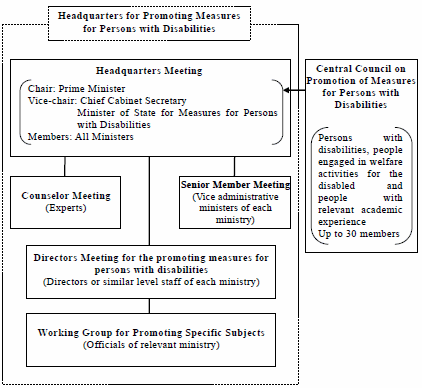
Source: Cabinet Office
Needs of Persons with Disabilities Concerning Living Environment and Information/ Communications
(Based on (preliminary) results of the Fiscal 2005 Comprehensive Survey on Measures for Persons with Disabilities)
The Cabinet Office decided to conduct the Comprehensive Survey on Measures for Persons with Disabilities, starting in fiscal 2005, in order to identify items that constitute “barriers” that hamper the social activities of persons with disabilities and clarify steps toward solutions. The decision is based on the provision of the Basic Program for Persons with Disabilities (Section IV “System for Promoting the Program”) that requires the government to “take effective and appropriate measures through exchanging views with organizations of persons with disabilities and researching the needs”and “examine the efficiency of the measures.”Specifically, the survey for fiscal 2005 was conducted in the form of questionnaires sent to persons with disabilities, with the support of the Japan Society of Rehabilitation of Persons with Disabilities, which is the secretariat of the Japan Disability Forum (JDF), and the forumfs member organizations.
The questionnaires were sent by post and through other means to 4,651 people in November through December 2005, of which 2,191, or 47%, provided answers. Although the survey for fiscal 2005 concentrated on the living environment and information/communications, two of the specific policy target areas cited in the Basic Program for Persons with Disabilities, the Cabinet Office intends to conduct surveys with regard to the other items in fiscal 2006 and later.
In the latest survey, replies came from at least two persons in every prefecture. With regard to the composition of respondents, people with physical disabilities accounted for 23.7%, those with internal disabilities 16.4%, those with mental disorders 13.6%, those with visual disabilities 10.9%, those with hearing disabilities 9.2%, those with intellectual disabilities 8.6%, those with intractable diseases 4.6% and those with development disabilities 2.2%.
Diagram 1-6 shows, based on the replies in the survey, the status of needs of persons with disabilities and convenience for them with regard to 25 items related to the living environment and information/communications, including transportation and public facilities. The survey asked respondents whether they used these items (in the past year for most items) and whether they experienced any inconvenience when using the items. Concerning items not used, the survey asked whether they were not used because there was no need or because of situational and other factors.
The far-left group in each line of the graph represents people who were unable to use the item concerned because of situational or other factors and the next group represents people who used the item but experienced inconvenience. The combined ratio of these two groups represents the ratio of people who perceived “barriers.” As shown in the diagram, the barrier-perceiving ratio for sidewalks, at nearly 60%, was the highest, followed by train stations/ railways, supermarket/ convenience/ department stores, restaurants and hospitals/ medical clinics, for all of which the ratio exceeded 40%. The high barrier perception ratios probably reflect the fact that these places and facilities are commonly visited and used in everyday life.
It should be noted that low barrier-perception ratios do not necessary mean better conditions for persons with disabilities. For example, take the case of airports/ planes, an item for which most respondents replied that they had no need for using in the past year. Although the ratio of people who perceived barriers is less than 20%, it is around the same as the ratio of people who said they did not experience inconvenience (the third group from the left), meaning that about half of people who needed to use airports/ planes perceived barriers. In a similar way, more than 60% perceived problems with regard to housing search, Internet, sign language and train stations/ railways.
Meanwhile, Diagram 1-7 shows the survey results concerning perceived improvement made over the past 10 years with regard to the usability/accessibility of eight items. Many respondents replied that they perceived “substantial” or “moderate” improvement with regard to all items, indicating that the society as a whole made progress toward becoming “barrier-free”.
Improvement was particularly remarkable for transportation, public facilities (government organizations, banks, etc.), telephones/ mobile phones, with the improvement-perceiving ratios for these items standing at around 60%. On the other hand, the ratios for housing, communications support, Internet, mass media, and daily goods were relatively low.
Details of the survey are available at http//www8.cao.go.jp/shougai/index.html.
Needs of Persons with Disabilities Concerning Living Environment and Information/ Communications
Diagram 1-6: Use or non-use of facilities and services and experiences of inconvenience
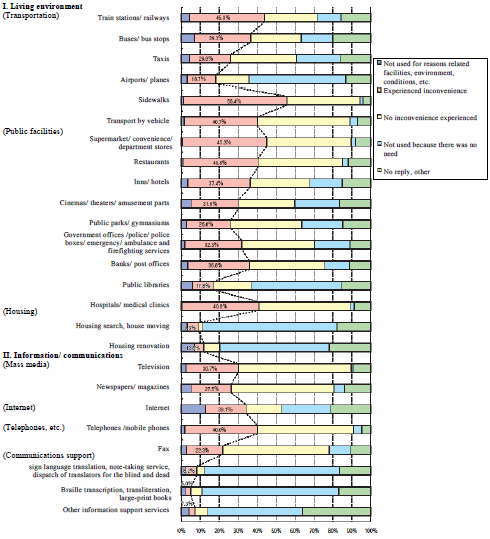
Source: Cabinet Office
Needs of Persons with Disabilities Concerning Living Environment and Information/ Communications
Diagram 1-7 Assessment of change in accessibility over the past 10 years
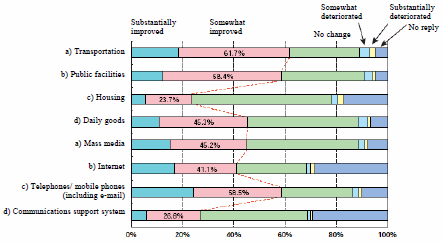
Figures in parentheses represent the combined percentages of people who indicated that accessibility improved substantially and those who indicated that accessibility improved somewhat.
Source: Cabinet Office
2. Promoting Mutual Understanding and Exchange
1) Raising Public Awareness and Understanding
- Following its amendment in June 2004, the Basic Law for Persons with Disabilities clarified the basic philosophy that discrimination for reasons related to disabilities is prohibited. Also, “Day of Persons with Disabilities” was renovated as “Week of Persons with Disabilities.” During the commemorative week, various events were held across the nation, as part of the governmentfs strenuous efforts to raise public awareness about and understanding of disabled people.
- The government has promoted welfare education through stepped-up exchanges and joint learning of the disabled and non-disabled conducted as part of school education and through awareness-raising activities targeting local residents. There have also been efforts to seek better understanding among public service employees for persons with disabilities and to enhance the general publicfs understanding for such persons by promoting volunteer activities, etc.
[Principal Measures Taken]
- In fiscal 2005, a full spectrum of projects for persons with disabilities were implemented mainly in Tokyo and Osaka, with a variety of events held during the Week of Persons with Disabilities. In Tokyo, seminars on a range of issues concerning persons with disabilities were held for three consecutive days in addition to the “Convention of the Week of Persons with Disabilities.” In Osaka, a symposium on the participation of persons with disabilities in society was held through the collaboration of administrative organizations, the financial sector and citizensf groups. A corporate exhibition and an exhibition of art works by persons with disabilities were also held in Osaka.
- Furthermore, local governments and private-sector organizations held a wide range of events, including the fifth Festival of Art and Culture for Persons with Disabilities in Yamagata, NHKfs Exhibition of the Heart and the Week of Persons with Disabilities Workshop 2005 organized by NISE (National Institute of Special Education).
- A “manual for interacting with persons with disabilities at public service counters” was compiled and distributed to public organizations across the nation, since civil servants and other public service workers must properly understand the needs of persons with disabilities to help ensure a comfortable community life for all members of society.
2) International Cooperation
- Japan takes steps to assure fairness with due consideration for persons with disabilities as one of basic policies of its ODA (Official Development Assistance). To this end, the government provided grant aid for the construction of rehabilitation and job training facilities for persons with disabilities, and extended a broad range of technical support measures, including the acceptance of trainees and the dispatch of experts and Japan Overseas Cooperation Volunteers. It also actively participated in the negotiations for the Convention on the Rights of Persons with Disabilities at the United Nations.
[Principal Measures Taken]
- Japan provided Grant Assistance for Grassroots Human Security Projects through NGOs (nongovernmental organizations) etc. for a total of 91 programs related to support for persons with disabilities, including plans to supply braillewriter equipment to Vietnam Blind Association to improve vocational training facilities for persons with disabilities in Ecuador and to build training and rehabilitation centers for adults with intellectual disabilities in Turkey.
- In fiscal 2005, Japan launched technical assistance projects in Malaysia and Rwanda.
- Japan, which had been making continuous financial contributions to the United Nations Voluntary Fund on Disability, provided 51,300 U.S. dollars to this fund in fiscal 2005. It also provided some 220,000 U.S. dollars to ESCAP (Economic and Social Commission for Asia and the Pacific)
- Japan sent a government delegation, including a representative from Japanese NGOs supporting persons with disabilities, to the sixth and seventh sessions of the U.N. Ad Hoc Committee on the Convention on the Rights of Persons with Disabilities.
3. Building the foundations for Independence and Participation in Society
1) Education/Training of Children with Disabilities
- In order to encourage the independence and social participation of children with disabilities, efforts are under way to promote individualized lessons tailored according to the severity of disability etc. at special schools such as schools for blind children, and those for deaf children, and those for children with intellectual disabilities, physical disabilities and health impairments, as well as in special classes and resource rooms at elementary and secondary schools. In addition, measures are being implemented in those special schools to deal more appropriately with severe disabilities or multiple disabilities and in regular elementary and secondary schools to support children suffering from learning disabilities (LD), attention-deficit/hyperactivity disorders (ADHD) and high-functioning autism.
- In December 2005, the Central Council for Education drew up a report titled “Future Vision for Special Needs Education.” In accordance with recommendations included in the report, the Bill for partial amendment of the School Education Law was submitted to the 164th session of the Diet, with a view to flexibly accommodating the needs of each child, facilitating the appropriate teaching and support.
[Principal Measures Taken]
- In December 2005, the Central Council for Education complied a report recommending that:
- Conventional ”special education” for children with disabilities should be turned into “special needs education” which provides appropriate teaching and support according to the needs of each child.
- The current school system, separated by types of disabilities, such as School for the Blind, School for the Deaf, School for the Intellectually Disabled, Physically Disabled and Health Impaired, should be turned into “Special Needs Schools” that handle all types of disabilities and have the function of regional centers to provide necessary support for elementary and secondary schools, etc.
- Resource room lessons should be made more flexible and cover children with LD (learning disabilities) and ADHD (attention-deficit/hyperactivity disorders).
- Different teacher licenses provided according to different types of disabilities should be integrated into the “License of the Special Schools.”
- Related issues should be widely considered to promote special needs education,including more opportunities for stepped-up exchange and joint learning between disabled and non-disabled children to improve activities.
- In accordance with the report submitted in December 2005 by the Central Council for Education, the Bill for partial amendment of the School Education Law, which provides the following measures, was submitted to the 164th session of the Diet, in order to flexibly accommodate the needs of individual children with disabilities, provide appropriate teaching and support.
- To convert the current school system into a Special Needs School system that enables the provision of education for children with different types of disabilities at each school.
- To promote special needs education at regular elementary and secondary schools as a way to enhance the education of children with disabilities.
- To integrate different teacher licenses provided according to different types of disabilities into the license of the “Special Needs Schools.”
- Efforts are under way to establish a system for the implementation of paramedical care at special schools for disabled children with a view to enabling teachers to engage in emergency care such as aspiration of suffocating phlegm with the cooperation and assistance of nurses under conditions in which medical safety can be ensured. In fiscal 2005, the government commissioned 35 prefectures with the implementation of the “project for establishing a system for implementation of paramedical care at schools for blind children, schools for deaf children and schools for children with intellectual disabilities, physical disabilities and health impairments.”
- Since fiscal 2003, the government has commissioned all prefectures with the implementation of the “project for the promotion of the special needs education system” in order to lay the foundation for a comprehensive education support system for children with LD and ADHD studying in regular elementary and secondary school classes. Based on the Law for Supporting Persons with Developmental Disabilities that came into force in April 2005, the coverage of this project was expanded in that year to include kindergartens and high schools in addition to elementary and secondary schools, so that consistent support may be provided to the disabled for the whole period from infancy to employment. The project has been carried out in harmony with the implementation of the “project for establishing a support system for persons with development disabilities.
- The time care project for children with disabilities was launched in fiscal 2005, as part of efforts to facilitate community-based care for children with disabilities, which also included training at child welfare facilities and programs for home-help services, day care services and short-stay services.
- Tsukuba College of Technology, an advanced education institution for people with hearing and visual disabilities, was reorganized in October 2005 into the National University Corporation Tsukuba University of Technology, a four-year university for practical skill training.
2) Work and Employment Promotion
- As work and employment are essential for promoting the independence of persons with disabilities and their participation in society, the government has been implementing measures to expand employment opportunities for such people, with particular emphasis on the mandatory employment quota system based on the Law for Employment Promotion etc. of Persons with Disabilities. It has also been seeking to expand the range of jobs available for persons with disabilities in areas suitable for their capabilities and aptitudes and promoting a variety of employment/working styles to suit the needs of the disabled.
- Given the importance of support tailored according to the type and severity of disability, the government has been implementing a comprehensive set of support measures, including the promotion of job rehabilitation coordinated with health and welfare as well as education, assistance for the transition to employment and enhancement of support for job capability development.
[Principal Measures Taken]
- In July 2005, the Law for Amending Part of the Law for Employment Promotion etc. of Persons with Disabilities was promulgated. This amendment law strengthens measures for employment of people with mental disorders and provides for assistance for persons with disabilities working at home and effective coordination between welfare measures and employment promotion measures for the disabled.
- The government published the status of achievements with regard to the mandatory employment quotas based on the Law for Employment Promotion etc. of Persons with Disabilities and called for compliance by private-sector companies and central and local government organizations that failed to meet the quota.
- In order to expand the range of jobs available for persons with disabilities, the government promoted employment through the special subsidiary system and implemented the “trial employment project” for the disabled.
- The government compiled a manual for employing persons with intellectual disabilities and mental disorders and implemented the “project for promoting employment of persons with development disabilities,” intended to educate employers about how to assign work for and supervise persons with development disabilities according to the characteristics of their disability.
- The government implemented the “project for promoting home-working by persons with severe disabilities” in cooperation with organizations engaged in a pioneering initiative in the area of home-work support using information technology (IT). At the same time, the government promoted the development of work-support equipment and related software programs at the National Institute of Vocational Rehabilitation and made efforts to raise awareness about the home-working initiative.
- In order to realize effective coordination between welfare measures and employment promotion measures for persons with disabilities, the following steps were taken.
- The “Employment and Living Support Centers for Persons with Disabilities” was used as a foothold for coordinating the activities of relevant organizations and providing integrated support to meet the needs in issues related to both employment and daily life.
- In order to facilitate the transition of persons with disabilities from welfare to regular employment, Hello Work offices, in cooperation with relevant organizations, started in fiscal 2005 the “community work support project for persons with disabilities,” intended to provide the disabled with consistent support for the period from pre-work preparations to settlement into the workplace. The project was implemented at 10 Hello Work offices across the nation.
- The government enhanced the “job coach” project, intended to help persons with disabilities adapt to the workplace, by starting to provide subsidies for the project in October 2005 under the amended Law for Employment Promotion of Persons with Disabilities in order to assist welfare facilities with relevant expertise.
| Mandatory employment quota | Actual employment rate | ||
|---|---|---|---|
| Private-sector companies | Ordinary private-sector companies | 1.8% | 1.49%(1.46%) |
| Special public corporations, etc. | 2.1% | 1.53%(1.71%) | |
| Central and local governments | Central government agencies | 2.1% | 2.14%(2.15%) |
| Prefectural government agencies | 2.34%(2.28%) | ||
| Municipal government agencies | 2.21%(2.20%) | ||
| Educational institutions in prefectures, etc. | 2.0% | 1.39%(1.33%) |
- Note
- Figures in parentheses are rates for June 1, 2004.
- Ordinary private-sector companies as referred to in the above table are companies that employ 56 or more regular workers.
- Special public corporations, etc. as referred to in the above table comprise special public corporations and incorporated administrative agencies
- Source
- Ministry of Health, Labour and Welfare
4. Building the Foundations for Daily Life
1) Measures to Stabilize Living Conditions
- The foundation for a user-oriented living support system has been laid through the provision of “assistance benefits,” the establishment of an accessible consulting support system and the promotion of the protection of the rights of persons with disabilities. Also, efforts have been made to deal with various types of disabilities more effectively, through measures such as enhancing at-home services, strengthening measures for people with mental disorders and people with development disabilities.
- The Law for Supporting Independence of Persons with Disabilities was enacted in October 2005 and was partially put into effect in April 2006. Under this law, the various sorts of welfare services that were previously provided according to the type of disability were integrated, with emphasis on user friendliness.
[Principal Measures Taken]
- The [assistance benefit] provision system, which allows persons with disabilities to choose the services they want and receive the services under contract, was promoted to reinforce at-home services such as home-help and short-stay services in order to allow the disabled to continue to live in a familiar community environment. This measure was carried out in line with the 5-Year Plan for Implementation of Priority Measures.
- The Law for Supporting Independence of Persons with Disabilities was enacted in October 2005 and partially put into effect in April 2006, providing for the following measures.
- To integrate the various sorts of welfare services previously provided according to the type of disability with regard to the three major disabilities?physical and intellectual disabilities and mental disorders?and provision of services based on the characteristics of each individualsf disability, etc.
- To restructure the service system into a user-oriented one, with emphasis shifted from in-facility services to the provision of care, training and community life support.
- To strengthen employment support
- To enhance the transparency over the decision-making process concerning the provision of support and clarify the process
- To stabilize the support system through review of the burden on users and clarification of the governmentfs fiscal responsibility
- As part of efforts to build a framework for providing consultations in an easily accessible setting, the project for municipal living assistance for persons with disabilities was implemented. In addition, centers for rehabilitation consultation and child consultation and mental health and welfare centers were built.
- The Law for Supporting Persons with Developmental Disabilities was put into effect in April 2005, providing for the following measures.
- To set the definition of development disabilities and clarify support recipient qualifications
- To provide assistance at a community level in an integrated way, with efforts to detect development disabilities early, extend early aid, and support education and employment
- To strengthen the framework of support based on the collaboration and linkage among relevant organizations
- To promote public understanding of development disabilities
- Since fiscal 2005, the “project for establishing the support framework for persons with development disabilities” has been implemented in coordination with the “project for promotion of special needs education system.” Research committees on the establishment of support systems for persons with development disabilities were set up at the prefectural level to create a regional support network with regard to health and medical care, welfare, education, employment, etc. to help draw up individualized support plans for persons with development disabilities. Thus, the framework for integrated support for people with development disabilities was strengthened to cover the whole period from infancy to adulthood, with appropriate assistance extended in each life stage.
- It is planned to establish support centers for persons with development disabilities in all prefectures and ordinance-designated cities by fiscal 2007 to support persons with such disabilities and their families in a comprehensive manner by enabling early detection of disabilities and early assistance.
- Japan dispatched a 40-member athlete delegation to the Paralympics Games held in Turin in March 2006 and won two gold medals, five silver medals and two bronze medals, a result far better than in the previous Paralympics games.
2) Health and Medical Care Measures
Efforts have been made to enhance the prevention, early detection and treatment of diseases through health checks, etc., and ensure safety at schools. In addition, measures have been taken to prevent work-related accidents and enhance medical rehabilitation service for persons with disabilities. Another focus of effort is the implementation of measures related to mental health and care, including support for the maintenance of sound mental conditions and early detection and treatment of mental disorders.
[Principal Measures Taken]
- As the proportion of people afflicted by so-called lifestyle diseases has risen due to the rapid aging of the society, it has become urgent to promote measures that put emphasis on disease prevention. To do this, the “Movement for Fostering Public Health in 21st Century (Healthy Japan 21) was promoted. Measures included in the “Health Frontier Strategy,” which focused on efforts to cope with lifestyle diseases and to prevent people from falling into conditions that require care, are due to be implemented intensively over a 10-year period starting from fiscal 2005.
- Measures were taken to promote the knowledge in the Manual for Promoting Anti-depression measures and the Manual for How to Deal with Depression as part of efforts to enhance mental health care. In addition, the government set up an “anti-suicide inter-ministry liaison council” in order to deal with the problem of high suicide rates in a comprehensive manner and formulated a report titled “On Governmentfs Comprehensive Policy for Suicide Prevention” in December 2005.
- In order to resolve the lack of a sufficient number of doctors capable of handling the mental health problems of children, a “study group on training of doctors specialized in pediatric mental health care” discussed how to secure doctors specialized in this field and considered training systems.
5. Building the foundations for a Comfortable Living Environment
1) Measures to Establish Comfortable Community for Persons with Disabilities
- Efforts are under way to promote housing built with due consideration for persons with disabilities and to improve the physical accessibility of buildings for public use, public transport and pedestrian space, based on the principle of “Universal Design.”
- Measures have been taken to ensure the provision of support tailored to the needs of people vulnerable in times of disasters, including persons with disabilities, in areas such as the diffusion of knowledge concerning disasters, the provision of information in the event of disasters and evacuation guidance.
- Crime prevention measures are being implemented with due consideration for the concerns of persons with disabilities. Efforts are also under way to remove obstacles to access by persons with disabilities to police and ease their concerns about the possibility of becoming crime and accident victims.
[Principal Measures Taken]
- In July 2005, the government announced the main points of the policy concerning the Universal Design initiative, which aims to create designs that realize “easy use for everybody, everywhere,” thus improving accessibility for not only elderly people and people with disabilities but all people. The main policy points showed how the government intends to implement the initiative with regard to social infrastructure construction and public transport administration.
- The Bill for Facilitating Movements of Elderly Persons and Persons with Disabilities was submitted to the 164th session of the Diet. The bill aims to promote measures to enhance the mobility of the elderly and disabled and secure easy access to buildings and other facilities, as part of efforts to promote a “barrier-free” environment in public facilities and ensure a comfortable life based on the main policy points of the Universal Design initiative.
- The revision of the ordinance concerning the enforcement of the Public Housing Law enabled people with mental disorders and those with intellectual disabilities, in addition to people with physical disabilities, to live alone in public housing, effective from February 2006.
- The Bill for Amending Part of the Road Transportation Law, etc. was submitted to the 164th session of the Diet. The bill provides for the establishment of a system that allows nonprofit organizations, etc. to provide paid welfare transport services to registered users in cases transport by buses and taxis is difficult and community officials agree to the arrangement, and it requires the maintenance of safety in such transport.
- In September 2005, a “study group on evacuation measures for people vulnerable in times of disasters” was set up to revise the guidelines on evacuation support for such people. The revised guidelines call for the establishment of contact points dedicated to vulnerable people in evacuation centers and the continuation of welfare services in emergencies.
2) Measures to Enable Disabled People to Lead Contented Life
- In order to encourage information barrier-free, research and development have been promoted with regard to information and telecommunications equipment and systems that take into consideration the needs of people with disabilities. There are also efforts under way toward diffusing such equipment and systems through the formulation of the guideline on information accessibility and the promotion of compliance with the JIS and international standards and toward improving the accessibility of web sites, etc.
- The provision of information to people with disabilities has been enhanced through the strengthening of information networks, the production of video materials with captions and the promotion of TV broadcasting with captions. In addition, the framework for communications support for people with disabilities has been strengthened through the promotion of sign language and Braille transcription as well as the standardization of communicative symbols.
[Principal Measures Taken]
- The JIS X8341 series, national standards for information technologies accessibility, was established with regard to the categories of etelecommunication equipmentf and eoffice equipment.f Thus, the standards have been established for five parts, as including ecommon guideline (for information telecommunications equipments, software and services),e einformation processing equipmente and eWeb content.f
- The “Study Group on Ensuring/Improving Accessibility in the Public Sector” was launched so that everyone including older persons and persons with disabilities can use public websites and web-systems. The Study Group compiled the “Operational models to improve accessibility of public websites” in December 2005.
- In April 2005, the “principles of communicative symbol designs (JIST0103)” were established. The principles constitute a standard for communicative symbols that are intended to enable people who have difficulty in communicating through written and spoken language to convey their intentions and needs accurately.
- *
- Securing employment and work is important for the promotion of participation in society of people with disabilities. From this point of view and based on the effectuation in April 2006 of the amended Law for Employment Promotion etc., of Persons with Disabilities and the Law for Supporting Independence of Persons with Disabilities, this report aims to encourage the public at large to consider ways to realize a society in which disabled people can exercise their abilities to the full through work. To this end, this report contains a special feature concerning employment and work support measures for people with disabilities that have attracted attention in recent years and new measures that are expected to be implemented in the future.
Special Feature
On Employment and Work Support for Persons with Disabilities -Toward Society that Supports Pursuit of Potential -
In order to promote the independence of persons with disabilities and their participation in society and create a society in which all people, with or without disabilities, can live together with dignity, it is necessary to tackle issues related to health, medical care, welfare, education, employment, etc. in a comprehensive manner. Particularly important is the provision of employment and work support for persons with disabilities.
In this context, this annual report explains employment and work support measures that have attracted attention in recent years and new measures expected to be implemented in the future, following the effectuation of the amended Law for Employment Promotion etc., of Persons with Disabilities and the Law for Supporting Independence of Persons with Disabilities. Thus, the report aims to provide an opportunity for the general public to consider ways to enable persons with disabilities to fully utilize their capabilities through their work and try a variety of possibilities.
Table of Contents
- Project to Support Continuation of Work
- Project to Support Transition to Regular Work
- Case studies: Transition-to-work support project 1
- Transition-to-work support project2
- Promotion of Transition from Welfare to Regular Employment (Community Work Support Project for Persons with Disabilities)
- Use of “Trial Employment” to Create Employment Opportunities for Persons with Disabilities
- Support by “Job Coaches” for Helping Workplace Adaptation
- Integrated Support for Employment and Living Needs (Project for Employment and Living Support Centers for Persons with Disabilities)
- Special Subsidiary System
- Support System for Home-Working Persons with Disabilities
- Employment Support at Special Schools for Disabled Children
Project to Support Continuation of Work
This project aims to provide work opportunities for persons with disabilities who face difficulty in finding jobs in ordinary workplaces and to provide training to enhance work-related knowledge and skills through engagement in production and other work activities. Under this project, there are two types of support--the “employment-type,” which involves an employment contract between the worker and the service provider, and the “non-employment type.
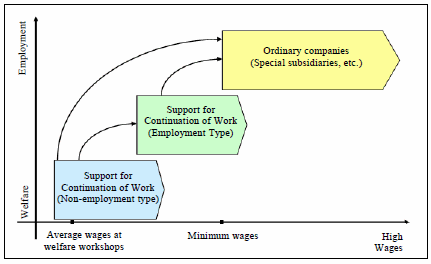
Employment Type
The employment type allows graduates of special schools for people with disabilities and disabled people who quit their jobs to work under an employment contract and aims to move such people from welfare to regular work. Non-disabled people may be employed at facilities engaged in this type of support within a number equivalent to 20% of the prescribed employee number, in addition to the prescribed number.
Non-employment Type
The non-employment type provides work opportunities for people who have difficulty engaging in regular work because of factors such as age and health conditions, by allowing them to work without an employment contract. In this support scheme, efforts should be made toward raising wages by setting target wages at each facility.
Project to Support Transition to Regular Work
This project provides in-facility job training, workplace training and post-employment support for settling into the workplace to people who wish to engage in regular work and who are likely to find suitable jobs if they start job search after acquiring the necessary knowledge, improving their abilities, and receiving hands-on training.
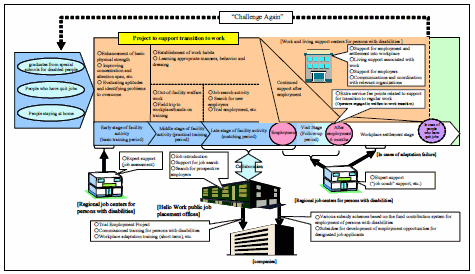
[Status of Employment of Persons with Disabilities]
It is very important for persons with disabilities to achieve independence through work. Therefore, it is necessary to expand opportunities for such people to obtain employment by fully utilizing their abilities and potentials.
However, only about 20% of the graduates of special schools for people with disabilities obtain regular jobs, and about 60% engage in activities at welfare facilities and workshops. Furthermore, among disabled people engaged in welfare facility activities, only about 1% go on to get a job.
Under these circumstances, it is necessary for welfare authorities to make strenuous efforts to provide work and employment support for persons with disabilities in an effective manner.
[Coordination between Welfare and Labor Measures]
As shown in the above diagram, the project to support the transition to regular work provides integrated assistance covering basic training for work to settlement into the workplace. At the same time, it utilizes the trial employment and commissioned training schemes for persons with disabilities, in a way coordinated with measures promoted by Hello Work offices and other entities, thus making the assistance more appropriate and effective.
Transition-to-Work Support Project 1(A case of support led mainly by welfare facility)
[Goal of Project-Leading Facility]
- To help people with disabilities acquire work capability and establish a basic life routine through activities in welfare workshops, daily life activities and physical exercises and to provide work-related consulting to disabled people staying at home and people with intellectual disabilities engaged in work.
- To promote participation in society and achievement of independence by providing work support for people engaged in in-facility activities and other people seeking counseling.
[Contents of Work Support]
Support recipients receive job training and lessons in social manners at welfare centers for about 2 years, with individualized support programs updated every four months and assessments of training results fed back to the recipients. Around the time of starting work, they will also receive support for settling into the workplace as follows.
(1)Workplace practical training scheme
This scheme provides practical training at companies and workshops in order to enable support recipients to gain self-confidence and prepare to start work through practical working experiences.
(2)Employment-with-support scheme
This scheme alleviates the employment-related concerns of persons with disabilities by deploying “job coaches” and designing jobs suitable for individuals' aptitudes.
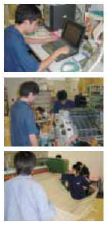
Transition-to-Work Support Project 2
(A case of support mainly based on collaboration among a network of support organizations in the community)
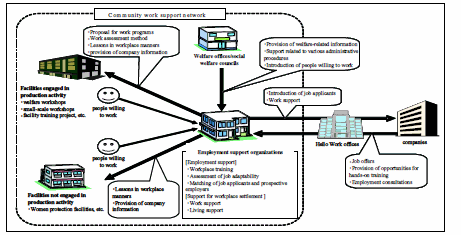
In this case, people at welfare facilities wishing to obtain employment will receive work support based on the utilization of social resources in the community. Specifically, partner companies will provide workplace training, and Hello Work services and job information magazines will be used to provide support. Also, support-providing organizations will assist welfare facilities by proposing employment support programs, for example.
[Main Operations]
(1) Assessment
To assess the current status of support recipients' work capability, sociability, self-management ability, based on the results of in-facility work and on-hands training at companies and to consider how to enable the recipients to exercise their abilities effectively
(2) Preparations for work (for people with intellectual disabilities)
To provide people aiming to obtain employment with training on the acquisition of concentration and attention span improvement techniques and the communications skills necessary for work and to help search for jobs suitable for their aptitudes.
(3) Efforts to expand the range of willing employers
To seek to expand the range of companies willing to employ persons with disabilities in sectors believed to be suitable for the disabled, by utilizing job information magazines and Hello Work offices as opportunities for approaching possible employers.
(4) Support for settling into workplace
To help persons with disabilities get used to their jobs and settle into the workplace smoothly by periodically visiting them at their employment site, providing advice and job support and resolving work-related problems with the support of Hello Work offices.
